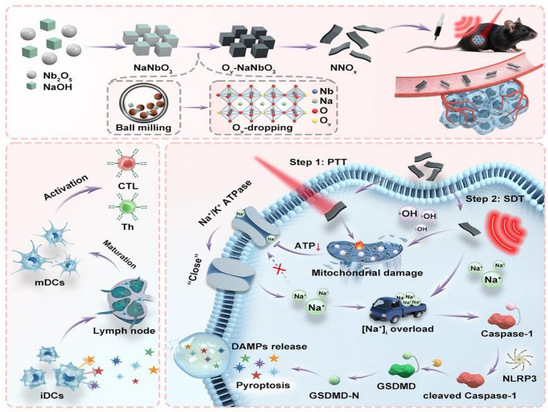Recently, Professor Luo Yu's team from the School of Chemistry and Chemical Engineering published a research paper titled Lattice storytelling Induced Niobium based Perovskite Polarization Cascade Regulates Na+/K+ATPase to Enhance Pyroptosis for Cancer Treatment in the academic journal Advanced Functional Materials (Top of the First Zone of the Chinese Academy of Sciences, Impact Factor 19.0).

Designing lattice-distortion-induced perovskite materials to disrupt intracellular soNa+ homeostasis via targeting sodium–potassium ATPase (Na+/K+ ATPase) has emerged as a promising therapeutic strategy in cancer treatment. However, precise manipulation of Na+ balance to achieve targeted anti-tumor effects remains challenging. Here, a lattice-distorted and oxygen vacancy-rich niobium-based perovskite, NaNbO3 (NNOx), is synthesized by utilizing the piezo-catalytic and photothermal properties of NNOx, and a cascade regulation of Na+/K+ ATPase is achieved. Particularly, under ultrasound and near-infrared II laser irradiation, NNOx not only releases exogenous Na+ to elevate local intracellular Na+ concentrations but also efficiently generates reactive oxygen species, inducing mitochondrial damage and impairing ATP synthesis in tumor cells. This mitochondrial dysfunction dramatically reduces Na+/K+ ATPase activity, impairs cellular Na+ efflux, and further exacerbates intracellular Na+ accumulation. Consequently, the severe ionic imbalance leads to rapid osmotic swelling and bubble formation, triggering pyroptotic cell death and robust anti-tumor immune responses. In vitro and in vivo studies demonstrate that NNOx efficiently suppresses tumor growth and activates potent anti-tumor immunity, highlighting an innovative strategy for ionic disruption-induced pyroptosis and immunogenic cell death. This approach provides valuable insights for future ionic homeostasis-targeted cancer immunotherapy.
This work was financially supported by the National Natural Science Foundation of China (Grant Nos. 52272280, 52302357), Shanghai Shuguang Plan (No. 22SG53), Shanghai Pujiang Program: 24PJD040, Jiangxi Provincial Natural Science Foundation (Grant Nos. 20232BAB213019, 20242BAB26056), and the Research Projects of Ganjiang Innovation Academy, Chinese Academy of Sciences (E355C002), and the Construction Project of Shanghai Engineering Research Center of Pharmaceutical Intelligent Equipment (20DZ2255900).
